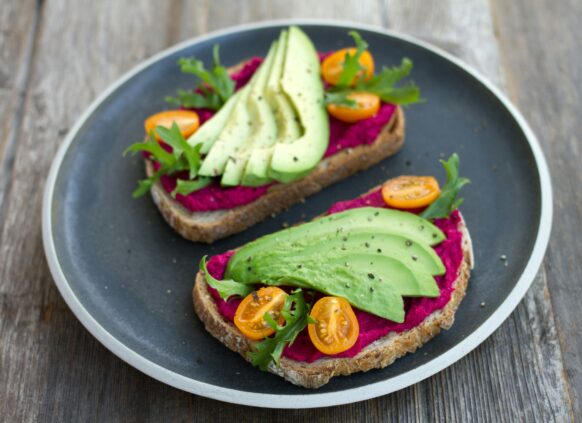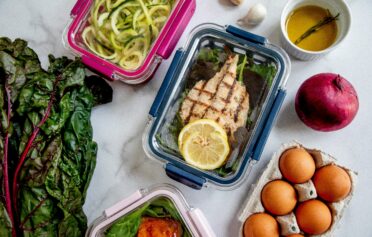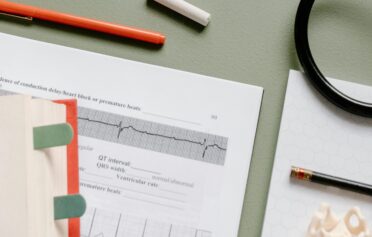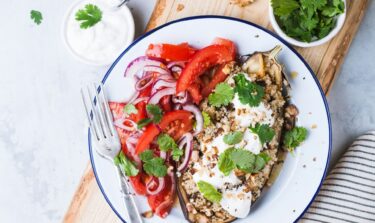
DASH diet: lowering your blood pressure with diet
Do you have high blood pressure? The DASH diet might be just what you need – it’s a flexible, everyday approach to managing high blood pressure that’s been proven to work.
If you’re struggling to get started or stay motivated, Oviva can help you build a balanced diet into your daily life through our weight management programme. You’ll be assisted by healthcare professionals, including doctors, dietitians and psychologists, who will offer tailored support.
Key takeaways
- The DASH diet is a recommended approach for people with high blood pressure.
- Its principles align with general healthy eating guidance and include eating more vegetables and whole grains, and less meat and salt.
- The DASH diet shopping list is also great for weight loss– you might even tackle two goals at once.
- With Oviva, making dietary changes is easier, and the programme is tailored to you.
What is the DASH diet?
The DASH diet is a dietary approach designed to reduce blood pressure and support overall long-term health. DASH stands for Dietary Approaches to Stop Hypertension.
Unlike many diets, the DASH diet isn’t based on calorie restrictions. Instead, the focus is on eating more vegetables, fruits, and whole grains and limiting saturated fats, salt and added sugar.
Oviva and the DASH diet
The recommendations are closely aligned with Oviva’s approach to weight management. In other words, in addition to supporting long-term health and lowering your blood pressure, if you follow the DASH diet, you’ll likely lose weight, too.
In many parts of the world, approximately a third of the population lives with high blood pressure. The DASH diet was developed in 1992 by the U.S. National Institutes of Health (NIH) to support healthy blood pressure and promote long-term health for other medical conditions.
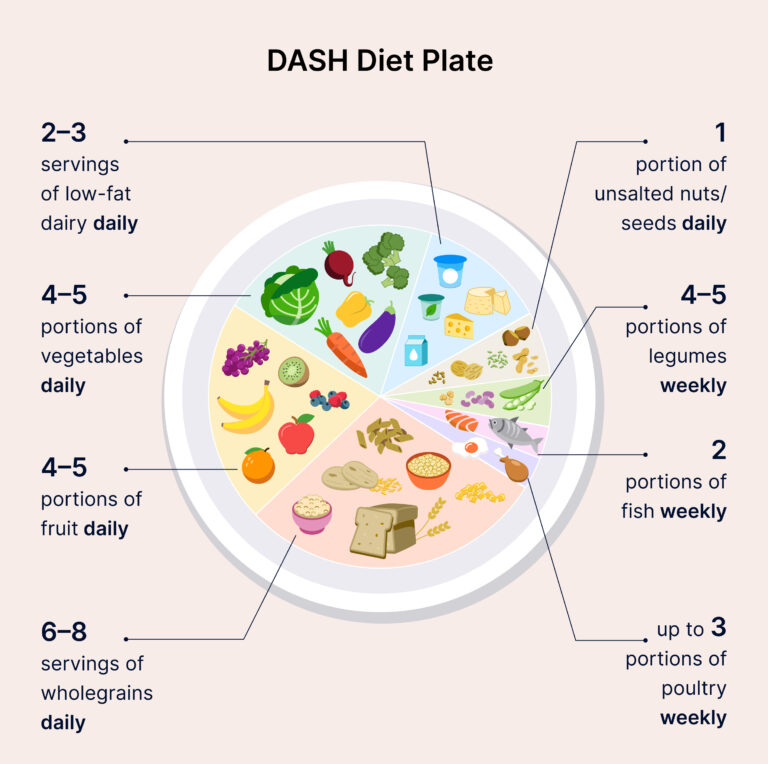

The DASH diet isn’t a typical ‘diet’ – you can follow it long-term, and it’s suitable for most people. Plus, the large portions of fresh food fit into any meal plan.
Veronika Alberts, qualified nutritionist at Oviva
How does diet affect blood pressure?
High blood pressure often develops as a result of a combination of factors. While we can’t change our genetics, we can influence other causes, especially diet. A diet high in salt, sugar and saturated fats, to name a few, can contribute to elevated blood pressure.
If too much salt is absorbed into the bloodstream, it draws in extra fluid, increasing blood volume and raising blood pressure.
Meanwhile, sugar and certain saturated fats contribute to arteriosclerosis – a vascular disease caused by inflammatory damage to blood vessel walls. This causes arteries to narrow and harden.
Arteriosclerosis and high blood pressure feed into one another: each makes the other worse.
Why is high blood pressure dangerous?
Blood pumping through arteries at high pressure gradually damages the vessel walls. This raises the risk of arteries narrowing and hardening which can lead to dangerous blockages that reduce blood flow to vital tissues and organs. Aneurysms (weakened, bulging vessels) may also form.
High blood pressure is particularly dangerous because symptoms often go unnoticed until serious complications occur: thrombosis, embolism, kidney failure, heart attacks, strokes or ruptured aneurysms can all be life-threatening.
How does the DASH diet work?
The DASH diet is based on medical insights into how high blood pressure develops:

- Limiting saturated fats (e.g., bacon, fatty sausages, burgers, cheese and cream) and sugar reduces the risk of arteriosclerosis, which narrows arteries and reduces elasticity.
- Plant-based fats, derived from nuts, seeds, and oils, help protect blood vessels.
- Reducing salt intake has a direct, positive effect on blood pressure.
- Minerals such as calcium, potassium, and magnesium, found in foods like low-fat dairy, bananas, nuts and tofu, also support healthy blood pressure.
Pros and cons of the DASH diet
The DASH diet’s effectiveness is scientifically proven and backed by UK and global health organisations. Its principles are also compatible with Oviva’s approach to weight management.
| Pros | Cons |
| Proven health benefits | More time spent on daily meal planning and preparation |
| Not many dietary restrictions | May be more expensive than the average diet |
| Fresh foods can fit into any meal plan, and these foods are easy to find | Can take time to adapt to, especially if you’re used to salty and hyper-palatable foods |
| Balanced nutrient intake, in keeping with official recommendations | |
| Can be adapted to suit different calorie and diet needs, including vegetarian and gluten-free diets |
Shopping list: recommended foods
Our DASH diet shopping list can help you understand the recommended foods on the DASH diet and the portion sizes you should be aiming for:
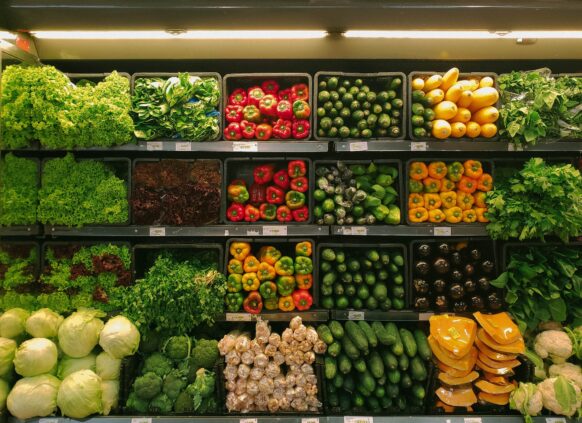
Vegetables and fruit
Rich in potassium and other blood pressure-friendly nutrients, you should choose fruits and vegetables you enjoy, such as:
- Aubergines
- Cucumber
- Cabbage
- Apples
- Lettuce
- Peppers
- Berries
- Tomatoes
- Avocados
- Rocket
- Onions
Aim for 4-5 portions of vegetables and 4-5 portions of fruit each day. A portion is around half a cup, one small apple, a handful of berries, or one cup of leafy salad.
Whole grain products
Research shows that whole grain foods may help reduce your risk of high blood pressure.
Examples of whole grain foods include:
- Wholemeal bread
- Whole wheat pasta
- Brown rice
- Whole grain rice
- Oats
- Quinoa
- Buckwheat
- Branflakes
Aim for 6-8 servings daily. A serving may be one slice of wholemeal bread, half a cup of cooked, whole grain or brown rice, or a handful of cereal.
Low-fat dairy
Low-fat dairy is a great source of protein and calcium, like:
- Low-fat milk
- Low-fat yoghurt
- Low-fat cottage cheese
Aim for 2-3 servings daily. A serving may be a yoghurt, 40 g of cheese, or a small glass of milk.
Protein guidance
It’s important to get enough protein in your diet. For an adult with minimal physical activity, it’s recommended to aim for 0.8 g of protein per kg of body weight.
You can calculate your recommended protein intake by multiplying your weight in kg by 0.8.
It’s best to focus on lean protein sources, like poultry and fish and to only eat red meat in moderation. Try to spread protein out throughout the day and aim to include plant-based protein sources in your diet too, like beans, nuts and pulses.
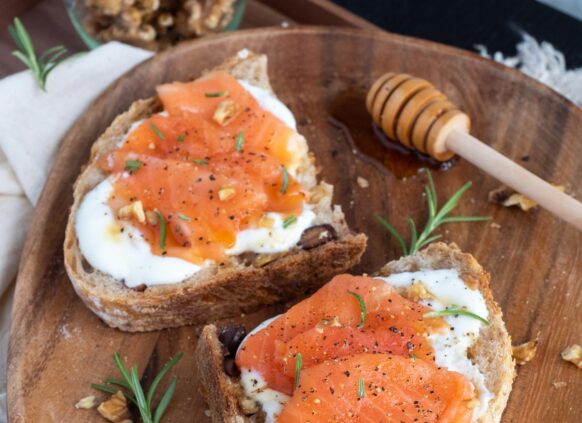
Fish
Fish is rich in protein and omega-3 fatty acids. The best choices include:
- Salmon
- Mackerel
- Tuna
- Sardines
- Herring
The Eatwell Guide recommends eating two portions of fish per week. The British Dietetic Association (BDA) advises that a portion of fish should be 140 g.
Poultry
Poultry can be a great source of lean protein. Stick to skinless products and avoid fried or breaded options. For example:
- Chicken breast
- Turkey breast
Aim to eat poultry up to 3 times per week. The BDA advises portions should be 90 g.
Legumes
A great source of plant-based protein and fibre. Some good option are:
- Beans
- Peas
- Lentils
- Chickpeas
Aim for 4-5 portions per week. A portion should be 150 g, or around four tablespoons.
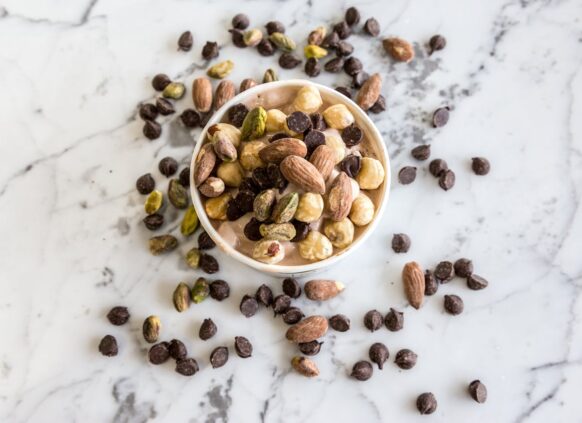
Nuts and seeds
A great source of healthy fats, protein, fibre and magnesium and a great snack option. You might want to try:
- Almonds
- Hazelnuts
- Walnuts
- Peanuts
- Sunflower seeds
- Pumpkin seeds
- Nut butters
Choose unsalted versions and aim for no more than one portion a day. A single portion should be 30 g or around a small handful of nuts, or one tablespoon of nut butter.
Vegetable oils
A good source of healthy fats and easy to include in your diet. Examples include:
- Olive oil
- Rapeseed oil
- Sunflower oil
- Pumpkin seed oil
Add around 2-3 teaspoons to hot and cold dishes on occasion. Aim for no more than three teaspoons in any given day, as vegetable oils are high in calories.
Discover more foods to lower high blood pressure
Foods to avoid
Eat the following foods only occasionally, if at all:
- Fatty red meat and processed meats, like sausages and burgers
- Full-fat dairy (e.g., whole milk, cream, butter, full-fat yoghurt and cheese)
- Sugary drinks (e.g., sugary soft drinks, fruit juice and iced tea)
- Sweets and cakes, including chocolate
- Salt – no more than 6 g (approx. a level teaspoon) daily, including hidden salt in processed foods. Check food labels for both ‘salt’ and ‘sodium’ to understand how much hidden salt may be in the foods you eat.
If you can avoid these entirely, even better; however, remember that the best diet is a sustainable one.
Can I lose weight on the DASH diet?
Yes – while the DASH diet is focused on lowering blood pressure, it can also support weight loss, depending on the size of your portions and your lifestyle.
That’s because it encourages a balanced diet of whole foods that are naturally lower in calories and higher in fibre, which can help you feel fuller for longer and reduce the likelihood of overeating.
While, ultimately, weight loss depends on whether you burn more calories than you consume, calorie counting is actually rarely helpful in the long term.
Instead, try to focus on eating nutrient-rich foods and increasing daily movement, including aerobic exercise, strength training and isometric exercises.
Who is the DASH diet suitable for?
The DASH diet is ideal for people with:
- High blood pressure
- Elevated blood lipids (cholesterol)
- Cardiovascular disease
However, it’s also suitable for:
- People with normal blood pressure who are living with overweight or obesity
- Healthy people aiming to prevent blood pressure issues and maintain a healthy weight
If you’re aiming for a long-term, balanced, healthy diet, the DASH diet is a useful guide.
Oviva: sustainable weight loss loss without calorie counting
If you have a BMI over 35 and a weight-related health condition like high blood pressure, you may be eligible for NHS-funded support through Oviva.
What you’ll get:
- Personalised coaching from doctors, dietitians and psychologists
- A plan focused on sustainable lifestyle changes, not strict diets
- Access to the Oviva app to track progress, log meals, and get expert feedback
- Tools to help you lower blood pressure and lose weight in a way that works for you
How we know it works:
- The HYPE clinical trial showed our programme led to greater reductions in systolic blood pressure than standard care
- Our approach is compatible with the DASH diet, helping you manage both weight and blood pressure
